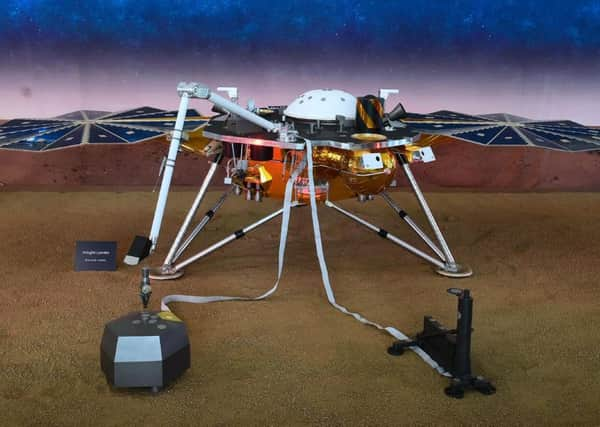NASA lander successfully touches down on surface of Mars


The InSight probe touched down on the Red Planet at around 8pm GMT, slowing its speed from 12,500mph to a 5mph jogging pace in just seven minutes.
Flight controllers announced that the spacecraft InSight touched down after a perilous supersonic descent through the red Martian skies.
Advertisement
Hide AdAdvertisement
Hide AdConfirmation came via radio signals that took more than eight minutes to cross the nearly 100 million miles (160 million kilometers) between Mars and Earth.
Live images showed the team at NASA celebrating after recieving the news.
It is now set to deploy instruments designed to probe beneath the Martian surface and collect information about the planet’s deep structure.
Three instruments designed and built in the UK are included in the spacecraft’s seismic package, which will listen out for “Marsquakes”.
Over the course of two years, scientists expect to detect between a dozen and 100 of the tremors, which could range up to six on the Richter scale.
The UK Space Agency has invested £4 million in the probe’s short period seismometer (SEIS-SP).
Sensors for the instrument developed at Imperial College London and Oxford University can detect motion at sub-atomic scales.
The UK team, led by Professor Tom Pike at Imperial, said: “We should be listening for Marsquakes for at least two years, and we hope considerably longer.
Advertisement
Hide AdAdvertisement
Hide Ad“It is critical that we set down the instrument in the best place to ensure we’re stable, and then follow up with adding a cover to shield our sensors from the wind.”
Colleague Dr Neil Bowles, from Oxford University’s Department of Physics, said: “The InSight SEIS-SP seismometer is one of the most sensitive and challenging instruments we have worked on for spaceflight in Oxford.”
Only around four in 10 missions ever sent to the Red Planet have been successful - and they have all been US spacecraft.
The European spacecraft Schiaparelli smashed into the planet in 2016 after switching off its retro-rockets too early, scientists believe.
It was testing the landing system for a British-built rover to be launched on the second phase of the ExoMars mission in 2020.
The thin Martian atmosphere means there is hardly any friction to slow down spacecraft.
InSight will rely on small rockets, parachutes, heat shields and shock-absorbing legs to manage the deceleration and ensure a soft landing on an equatorial region called Elysium Planitia.
If successful, the three-legged probe will help scientists learn about how rocky worlds like the Earth and Moon formed more than 4.5 billion years ago.
Advertisement
Hide AdAdvertisement
Hide AdLori Glaze, acting director of the Planetary Science Division at the American space agency Nasa, said: “Once InSight is settled on the Red Planet and its instruments are deployed, it will start collecting valuable information about the structure of Mars’ deep interior - information that will help us understand the formation and evolution of all rocky planets, including the one we call home.”
InSight was launched from California on May 5.
The mission coincides with the discovery of a 12-mile lake of water beneath the southern Martian ice cap earlier this year.
An orbiting European probe found the lake using ground-penetrating radar. The presence of a large body of liquid water on Mars has major implications for the chances of life surviving on the planet.
The European ExoMars Trace Gas Orbiter (TGO), which is currently circling Mars, will be used to “sniff” any gases released by seismic events detected by InSight.
TGO scientist Dr Manesh Patel, from the Open University, said: “This could potentially provide a way to unlock the secrets to what hides beneath the Martian surface.”
InSight stands for Interior Exploration using Seismic Investigations, Geodesy and Heat Transport.